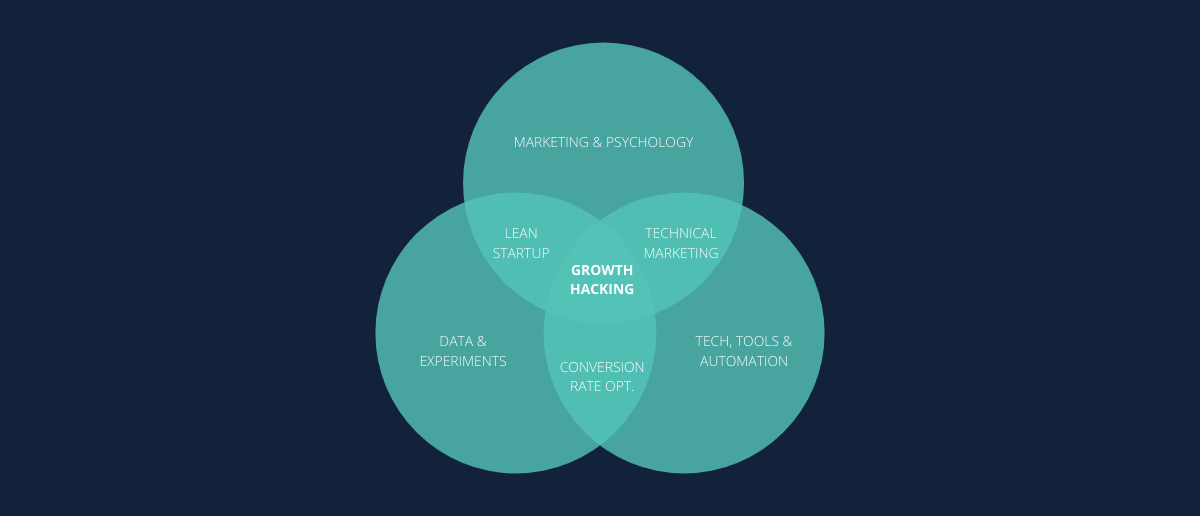
Growth Hacking: The Marketing Trick for Rapid Scaling
Tuesday, 27 July 2021Scaling is the main task of any startup. Growth hacking is an important aid in this process. Regardless of their mission or product, founders need to achieve the exponential growth of their company. This doesn’t just mean expanding the business model but also scaling without significant investment.
The better the ratio of effort to growth, the more scalable a business model is. However, this does not mean that every startup is scalable; digital business models, in particular, manage to expand and meet demand in a resource-efficient manner. Startups with low initial investments, low fixed costs, and a high degree of automation also have good chances.
The solution for rapid growth without high costs is a form of growth marketing: growth hacking. Growth hacking allows marketing experts to lead the startup to maximum growth in a short period of time and at a low cost.
Growth Hacking sets itself apart from traditional marketing and its channels and instead focuses on agile optimization of all marketing and communication activities. This makes the strategy a perfect fit for innovative startups driven by agility and the Lean Startup methodology.

What is Growth Hacking?
The strategy to reach a broad audience with low financial resources wants to create new solutions. The traditional marketing mix from the classic marketing department is not enough for a disruptive startup to scale quickly and thus become one of the few startups that do not run out of steam after 2 or 3 years.
The term has been established in 2010 and has created its own professional field: Growth Hacker. Their job is basically that of the classic marketing expert: to move users from one step to the next, to track conversions, and thus guide them through the funnel. However, the term already reveals that the goal is not just any growth, but growth through “hacks”.
The word “hack”, which can be traced back to the IT field, means a trick or a ruse. Thus, the goal of growth hacking is to attract and retain the maximum number of users to the product by using tricks. The hope is that the trick allows fast, effective, and resource-saving action.
Growth hacking differs from “normal” performance marketing in that creativity, curiosity, and analytical thinking determine the work of the growth hacker.
The Growth Hacker
Accordingly, the Growth Hacker is someone who combines their creativity together with modern technologies and digital phenomena to reach broad masses. Not least because his ingenuity is crucial to the success of Growth Hacking, his personality also plays a major role.
Tasks of the Growth Hacker
To drive business growth, the Growth Hacker’s work process goes through the same 5 steps of the classic marketing mix.
- Acquisition: attracting interested, potential customers
- Activation: the initial user experience
- Retention: customer loyalty
- Monetization: converting them into a paying customer
- Referral: turning customers into brand ambassadors

The growth hacker is extremely strategic and targeted in his work. As he has practically no other choice. Startups have to cut corners, especially when it comes to growth hacking, which by definition has to be cost-effective.
A lack of resources and entrepreneurial skill present the growth hacker with a mammoth task. Not only does he have to generate radical growth with very limited resources, but he also has to make up for deficits and fight against established companies with high marketing budgets.
Like the classic performance marketing manager, the growth hacker must make his decisions based on data. Growth hacking as a technology-based discipline requires profound knowledge in dealing with large amounts of data. Extensive prior knowledge is therefore essential. In addition, no decision or optimization may be made that is not supported by data analyses.
Growth Hacking Tools
A Growth Hack is always a highly individual trick. Copying or reusing hacks contradicts the growth hacking strategy. Hacks are individually adapted to companies and their target group and therefore work best for them. In addition, hacks often work with a surprise effect that is of course lost with replication.
The last step of the funnel, referral, is also an important part of the strategy. Once customers have been made aware of the company’s product, the next goal is a perpetual cycle of telling and recommending others. In the best case, word-of-mouth leads to the explosive growth of the startup within a short period of time. The ultimate goal here is that the product markets itself, and thus the marketing costs drop to practically 0.
Virality
Virality is also a particularly popular tool. Viral marketing is not considered growth hacking per se, but it follows similar approaches and is also a popular startup tool. Viral marketing aims to link unusual, funny, and surprising content with a brand, which in the best case spreads like wildfire on the Internet. This makes it possible to address particularly large target groups with, particularly little effort.
“Virality isn’t luck. It’s not magic. And it’s not random there’s a science behind why people talk and share. A recipe. A formula, even.” – Jonah Berger
Particularly positive examples in recent years were, for example, the Edeka Christmas film under the #heimkommen or the BVG campaign under the motto “Because we love you”.
It should be said beforehand that countless growth hacks already exist and new ones are also being discovered every day. Especially since growth hacking is closely linked to social media, trends lead to new hacks all the time. So the following tools are just a manageable selection of potential tools to scale a startup.
1. Blog
Create relevant content that encourages readers to share. Especially with niche topics, lists, useful tips, how-to’s, and infographics you generate more traffic to your site.
Fintech Mint.com has also made use of this strategy – the blog on the topic of private finances is widely shared on social media. But not only content from your own website is part of the marketing mix – guest posts in other blogs draw new users to you and your company.
2. Landing-Pages and Search Engines
Search engines are a ubiquitous and 100% free advertising space. Optimize your keywords and landing pages to get more traffic to your website that way, too. For example, by using additional snippets, such as site link, rating, or location extensions, or testing new features with the trial-and-error principle, you can find optimization opportunities through data analysis. Well-placed CTAs also direct your users specifically into a conversion funnel.
3. Automatization
To establish a sustainably successful strategy, make sure your content and branding practically spread themself, ideally through large, well-known websites.
Airbnb has done this successfully. The startup offered its customers to post their listings on its site automatically on Craigslist, the best-known American advertising website. In this way, Airbnb benefits from Craigslist’s popularity without paying a single cent for it.
4. Retargeting
A customer who has already made a purchase from your company is many times more likely to buy a product than a new customer. Although this correlation may be obvious, marketers continue to underestimate the power of retargeting.
Another target of retargeting are customers who have already visited the website but have not yet completed a purchase. On average, between 7 and 10 impulses are needed to persuade a prospect to make a purchase. A single website visit is often not enough. Retargeting strategies are therefore used to reach interested parties outside the company’s own website.
5. Referral Programs
This growth hack has already proven itself many times over and will therefore not disappear from the scene anytime soon. It is important for affiliate programs that the customer is offered added value, which is also so interesting that others are willing to actively promote the product.
Dropbox is probably the best-known example of a startup that became successful through an affiliate program. However, Shopify, Clickfunnels, and Dreamhost also experienced rapid growth as a result. Dropbox also proved that compensation doesn’t always have to be monetary – referrals merely gave users more free storage space, and the company grew from 100,000 to 4 million users.
6. Fake User
Fake it till you make it! There is also cheating in growth marketing. Reddit created hundreds of fake profiles at the time to make the site appear popular. But it gets even more perfidious: many dating apps and platforms employ people who use fake profiles to write with real users so that they remain interested or, in the worst case, spend money to continue writing with the fake profile.
7. Content Upgrades
In order to reach the favored target, many online marketers use so-called content upgrades in addition to their “standard” content. On the one hand to generate new leads, on the other hand, to further strengthen the relationship with existing customers. Content upgrades are an extremely specific form of bonus content that fits perfectly into the theme of a blog post. The most popular forms are checklists, PDF blogposts, starter guides, or free e-books.
8. Use FOMO to your advantage
The fear of missing out is a social phenomenon that affects our lives both online and offline. Nobody wants to miss a great event or a good party. The forces of social media reinforce this phenomenon: 56% of social media users fear missing something important if they don’t check their news feeds regularly. Marketers take advantage of this fear by creating artificial time pressure. Timers for time-bound offers or special promotions encourage users to buy.
Challenges of Growth Hacking
As mentioned earlier, growth hackers need to be able to reconcile many aspects – traditional marketing, modern technologies, customer service, sales, and HR – all of these and more need to be combined into one strategy.
One of the biggest challenges of growth hacking is the transition from old, traditional marketing strategies to new, growth-oriented approaches. This is because new processes must first be structured and digitized in order to be lived in the company’s human workflow. A well-integrated management system can help to incorporate the company’s other systems.
Finding the right people for a growth hacking project can also be difficult. Not every online marketing expert is automatically suitable as a growth hacker. Such an employee must have extensive knowledge of creative marketing, but also knowledge of technology topics such as AI or user experience, as well as knowledge of handling large amounts of data.

Bottom Line
Growth hacking is not limited to startups – SMEs and large companies are now also convinced by the marketing strategy. Likewise, the marketing method is not limited to B2C companies but is just as applicable in B2B.
There are countless hacks and strategies on how your startup can scale. However, since ultimately the success of any growth hack depends on the individual situation, the startup, current trends, and social circumstances, you need to find out for yourself which ones work for your startup.
But also be on your guard. Growth hacking has often been criticized for replacing a deep marketing strategy with quick and easy hacks. Be careful not to let the success of shortcuts through growth hacks make you forget about a comprehensive overall strategy.
As a final tip, don’t wait too long. Ideally, start your growth hacking strategy already during product development and not after launch.